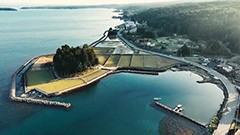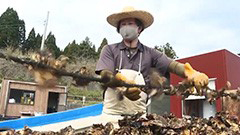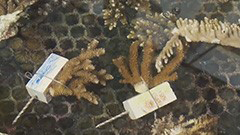Aiming for the sustainable use of coastal resources and the achievement of SDG14

"Satoumi" consept, which has been developed in Japan and harmonized co-existence of people and sea, can contribute to the achievement of SDGs14.
The climate change, marine pollution and coastal development have affected fragile coastal environment in many countries, threatening livelihoods of coastal communities. In coastal areas of Japan, it is widely recognized that healthy environment offers a good basis for stable livelihoods and hence coastal communities naturally place a high importance on environmental conservation when they conduct economic activities by utilizing aquatic resources. Through such traditional practices, "Satoumi "concept has been developed in Japan, whereby harmonized co-existence of people and sea is sought.
This JICA-Net multimedia-based learning material, "Satoumi Co-creation: Coexistence of People and the Sea" (Youtube, external link) aims to disseminate useful knowledge and experiences on promoting Satoumi, which are expected to contribute to the sustainable use of coastal resources as well as the achievement of SDG14.
Satoumi as the practice of living in harmony with the natural environment
Satoumi is a socio-ecological system where people's life and coastal environment/ ecosystem interact each other. In this material, two well-known Satoumi areas are introduced, namely Noto peninsula in Ishikawa prefecture and Onna village in Okinawa prefecture.
In Noto peninsula, oyster farmers help restoring forest by planting trees to improve nutrient flow to the sea and oyster shells are recycled to fertilizer to reduce wastage from oyster farming. "Ama" female fishers continue their livelihood activities of harvesting abalone/turban shells for nearly 400 years without over-exploiting resources by simply exercising their own management rules. As a result of these efforts, this area has been designated as the first site of FAO's globally important agricultural heritage system (GIAHS) in Japan.

In Noto peninsula, oyster farmers help restoring forest by planting trees to improve nutrient flow to the sea and oyster shells are recycled to fertilizer to reduce wastage from oyster farming.

In Onna Village, fishers' indigenous knowledge was utilized for restoration of damaged coral reefs.
In Onna Village, fishers' indigenous knowledge was utilized for restoration of damaged coral reefs, which brought positive effects on Mozuku seaweed production. Many residents of urban areas supported this coral reef restoration with "Mozuku fund" raised through consumption of Mozuku products. In this village, fishers, farmers and local communities come together to co-create Satoumi
To share Japan's experiences on Satoumi
It is believed that satoumi is a concept that can be applied everywhere. As long as people recognize the importance of conserving coastal environment, the connection of land and sea for material cycle, and the value of the traditional culture and knowledge of the local people, there would be a satoumi. As such, it is expected that this material will be widely used for disseminating the Satoumi concept to the people of developing countries, especially for the practitioners of fisheries and environmental management.
It is our hope that by watching with this material, people come to rethink the relationship between human and environment, and initiate the efforts to create their own Satoumi in many areas.
HONDA Masaru
JICA Economic Development Department
*The Material(s) mainly applied
Satoumi Co-creation: Coexistence of People and the Sea
"Satoumi" is a socio-ecological system practiced in Japan, where coastal communities endeavor to achieve harmonised co-existence of people's livelihoods and the nature. In this material, key elements of co-creation of Satoumi by various stakeholders are introduced and some practical ideas of applying this approach in developing countries are presented.
The climate change, marine pollution and coastal development have affected fragile coastal environment in many countries, threatening coastal communities' livelihoods. This material aims to disseminate useful knowledge and experiences on promoting coexistence of the people and nature, which are expected to contribute to the sustainable use of coastal resources as well as the achievement of SDG14.




scroll